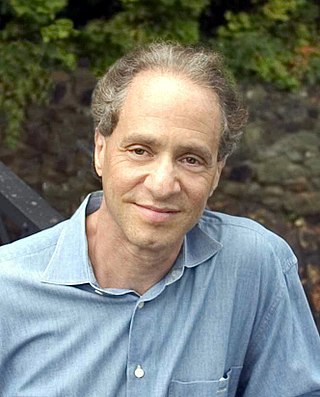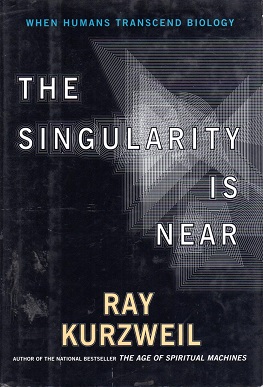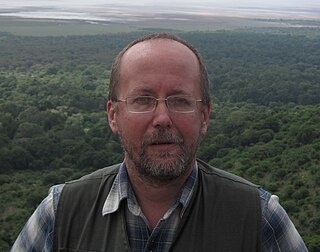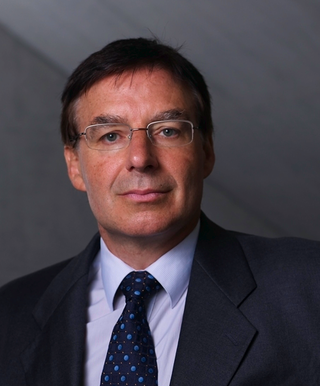
In economics, Kondratiev waves are hypothesized cycle-like phenomena in the modern world economy. The phenomenon is closely connected with the technology life cycle.

Raymond Kurzweil is an American computer scientist, author, inventor, and futurist. He is involved in fields such as optical character recognition (OCR), text-to-speech synthesis, speech recognition technology, and electronic keyboard instruments. He has written books on health, artificial intelligence (AI), transhumanism, the technological singularity, and futurism. Kurzweil is a public advocate for the futurist and transhumanist movements and gives public talks to share his optimistic outlook on life extension technologies and the future of nanotechnology, robotics, and biotechnology.
The technological singularity—or simply the singularity—is a hypothetical future point in time at which technological growth becomes uncontrollable and irreversible, resulting in unforeseeable changes to human civilization. According to the most popular version of the singularity hypothesis, I.J. Good's intelligence explosion model, an upgradable intelligent agent will eventually enter a "runaway reaction" of self-improvement cycles, each new and more intelligent generation appearing more and more rapidly, causing an "explosion" in intelligence and resulting in a powerful superintelligence that qualitatively far surpasses all human intelligence.

The future is the time after the past and present. Its arrival is considered inevitable due to the existence of time and the laws of physics. Due to the apparent nature of reality and the unavoidability of the future, everything that currently exists and will exist can be categorized as either permanent, meaning that it will exist forever, or temporary, meaning that it will end. In the Occidental view, which uses a linear conception of time, the future is the portion of the projected timeline that is anticipated to occur. In special relativity, the future is considered absolute future, or the future light cone.

Singularitarianism is a movement defined by the belief that a technological singularity—the creation of superintelligence—will likely happen in the medium future, and that deliberate action ought to be taken to ensure that the singularity benefits humans.

The Singularity Is Near: When Humans Transcend Biology is a 2005 non-fiction book about artificial intelligence and the future of humanity by inventor and futurist Ray Kurzweil.
Futurists are people whose specialty or interest is futurology or the attempt to systematically explore predictions and possibilities about the future and how they can emerge from the present, whether that of human society in particular or of life on Earth in general.

Futures studies, futures research, futurism or futurology is the systematic, interdisciplinary and holistic study of social and technological advancement, and other environmental trends; often for the purpose of exploring how people will live and work in the future. Predictive techniques, such as forecasting, can be applied, but contemporary futures studies scholars emphasize the importance of systematically exploring alternatives. In general, it can be considered as a branch of the social sciences and an extension to the field of history. Futures studies seeks to understand what is likely to continue and what could plausibly change. Part of the discipline thus seeks a systematic and pattern-based understanding of past and present, and to explore the possibility of future events and trends.
In futures studies and the history of technology, accelerating change is the observed exponential nature of the rate of technological change in recent history, which may suggest faster and more profound change in the future and may or may not be accompanied by equally profound social and cultural change.

Erich Jantsch was an Austrian-born American astrophysicist, engineer, educator, author, consultant and futurist, especially known for his work in the social systems design movement in Europe in the 1970s.

J. Doyne Farmer is an American complex systems scientist and entrepreneur with interests in chaos theory, complexity and econophysics. He is Baillie Gifford Professor of Mathematics at Oxford University, where he is also Director of the Complexity Economics at the Institute for New Economic Thinking at the Oxford Martin School. Additionally he is an external professor at the Santa Fe Institute. His current research is on complexity economics, focusing on systemic risk in financial markets and technological progress. During his career he has made important contributions to complex systems, chaos, artificial life, theoretical biology, time series forecasting and econophysics. He co-founded Prediction Company, one of the first companies to do fully automated quantitative trading. While a graduate student he led a group that called itself Eudaemonic Enterprises and built the first wearable digital computer, which was used to beat the game of roulette.
Technology forecasting attempts to predict the future characteristics of useful technological machines, procedures or techniques. Researchers create technology forecasts based on past experience and current technological developments. Like other forecasts, technology forecasting can be helpful for both public and private organizations to make smart decisions. By analyzing future opportunities and threats, the forecaster can improve decisions in order to achieve maximum benefits. Today, most countries are experiencing huge social and economic changes, which heavily rely on technology development. By analyzing these changes, government and economic institutions could make plans for future developments. However, not all of historical data can be used for technology forecasting, forecasters also need to adopt advanced technology and quantitative modeling from experts’ researches and conclusions.

Andrey Vitalievich Korotayev is a Russian anthropologist, economic historian, comparative political scientist, demographer and sociologist, with major contributions to world-systems theory, cross-cultural studies, Near Eastern history, Big History, and mathematical modelling of social and economic macrodynamics.
Leonid Efimovich Grinin is a Russian philosopher of history, sociologist, political anthropologist, economist, and futurologist.

Graeme Donald Snooks is a systems theorist and stratologist who has developed a general dynamic theory to explain complex living systems. His resulting "dynamic-strategy theory" has been employed to analyse the fluctuating fortunes of life over the past 4,000 million years (myrs) and of human society over the past 2 myrs; to analyse contemporary economic problems ; to explore socio-political issues ; to analyse the emergence, operation, and malfunction of the mind; and to make scientific predictions about the future. New discoveries emerging from Snooks' publications include: existential schizophrenia, strategic frustration, strategic selection, the growth-inflation curve, the strategy function, the logological constant, the Snooks–Panov Vertical, technological paradigm shifts, the Solar Revolution, and, most importantly, the strategic logos. His body of work challenges the existing paradigms of orthodox (neo-classical) economics, climate-mitigation economics, Marxism, neo-Darwinism, evolutionary psychology, self-organisation theory, and all other supply-side systems.

Didier Sornette is a French researcher studying subjects including complex systems and risk management. He is Professor on the Chair of Entrepreneurial Risks at the Swiss Federal Institute of Technology Zurich and is also a professor of the Swiss Finance Institute, He was previously a Professor of Geophysics at UCLA, Los Angeles California (1996–2006) and a Research Professor at the French National Centre for Scientific Research (1981–2006).
Tessaleno Campos Devezas is a Brazilian-born Portuguese physicist, systems theorist, and materials scientist. He is best known for his contributions to the long waves theory in socioeconomic development, technological evolution, energy systems as well as world system analysis.
The following outline is provided as an overview of and topical guide to futures studies:

Theodoros Modis was a Greek lumber merchant and scholar from Monastiri.












